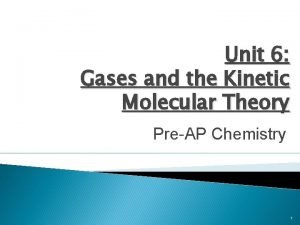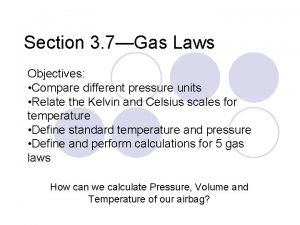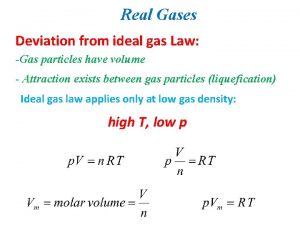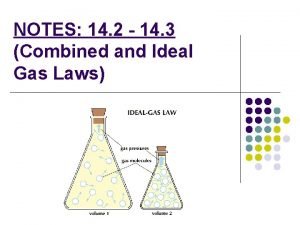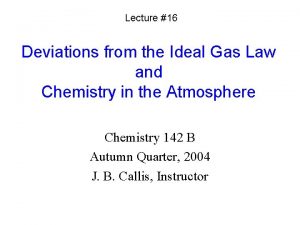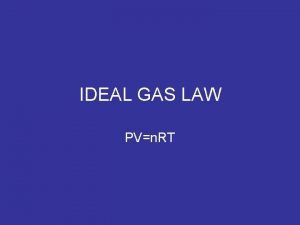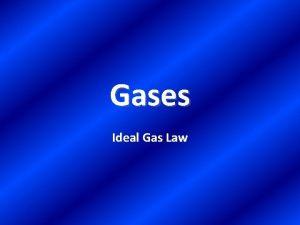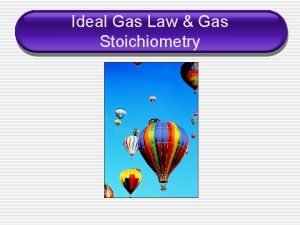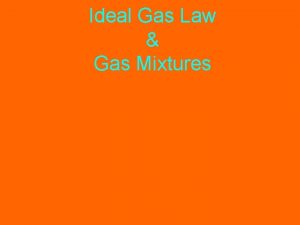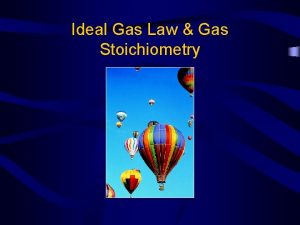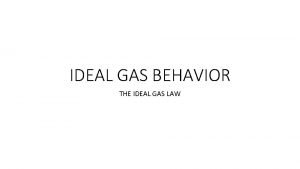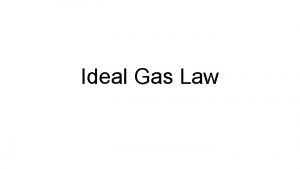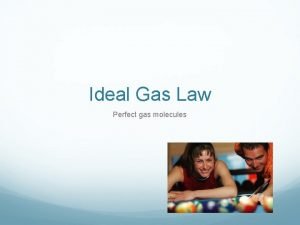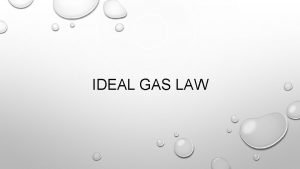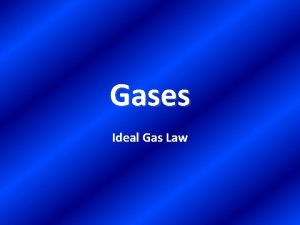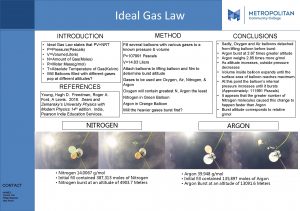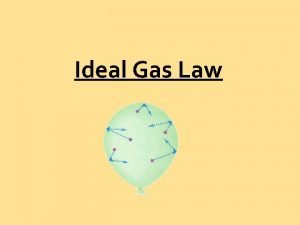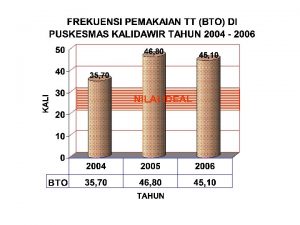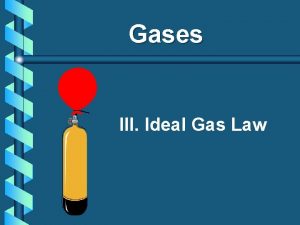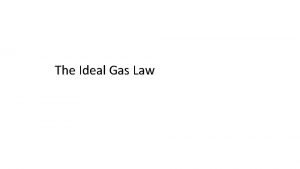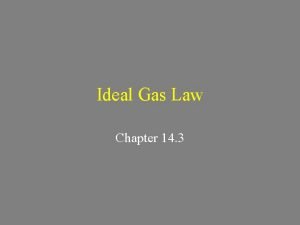Ideal Gas Law Ideal Gas Law For every



















- Slides: 19

Ideal Gas Law

Ideal Gas Law For every problem we have done, we also could have used the ideal gas law. l On the test, you will have to do a couple of problems with the combined gas law, some with the ideal gas law and then you will be able to choose which law you want to use. l

Ideal gas law can be derived from the combined gas law l l l PV/T = PV/T (using k. Pa for pressure) n (22. 4) = Volume of any gas at STP (n is the number of moles) plug this into combined gas law for initial state. PV/T = (101. 2 k. Pa) (n • 22. 414 L) / 273 K PV = n (8. 31 k. Pa • L/K mol) T 8. 31 k. Pa • L/K mol is the ideal gas constant for these units. It is abbreviated “R”

The equation l l l PV = n. RT *R can also be. 0821 atm • L/K mol *R can also be 62. 4 torr • L/K mol The units of R must match the other units in the problem. If you are using 8. 31 k. Pa • L/K mol, your units are: k. Pa(L) = mol (8. 31 k. Pa • L/K mol) K

Converting pressures l l l Use the standard pressures as a conversion factor 1. 00 atm = 101 k. Pa = 760. torr convert 135 k. Pa to atm 135 k. Pa x 1 atm / 101 k. Pa = 1. 34 atm convert 768 torr to k. Pa 768 torr x 101 k. Pa / 760 torr = 102 k. Pa

Using the ideal gas law l l l What volume will. 76 mol of a gas occupy at. 82 atm and 264 K? PV = n. RT 0. 82 atm x 101 k. Pa / 1. 00 atm = 82. 82 k. Pa 82. 82 k. Pa V = 0. 76 mol (8. 31 k. Pa • L/K mol )264 K V = 20. L

Ideal Gas Law Problem l l l If a gas occupies 14 L at 135 k. Pa and 285 K, what volume will it occupy at STP? PV = n. RT 135 k. Pa (14 L) = n 8. 31 k. Pa • L/K mol (285 K) n =. 798 mol x 22. 4 L / 1 mol = 18 L

or you can also l l take the. 798 mol and plug it back into PV = n. RT (you would have to do this if you were not going to STP) 101 k. Pa V= (. 798 mol) 8. 31 (273 K) V = 18 L (still)

Ideal Gas Law Problems

Number 1 l l 1. 54 mol of helium will occupy what volume at 92 k. Pa and 315 K? PV = n. RT

Number 1 l l 1. 54 mol of helium will occupy what volume at 92 k. Pa and 315 K? PV = n. RT 92 KPa V = 1. 54 mol (8. 31) 315 K V = 44 L

Number 2 l l 126 m. L of nitrogen at 113 k. Pa and 39 o C will occupy what volume at STP? PV= n. RT

Number 2 l l l 126 m. L of nitrogen at 113 k. Pa and 39 o C will occupy what volume at STP? PV= n. RT. 126 L (113 k. Pa)= n(8. 31)312 K n =. 00549 mol x 22. 4 L/1 mol V =. 123 L (123 m. L)

Number 3 l 2. 14 g of NH 3, ammonia, will occupy what volume at 795 torr and 315 K?

Number 3 l l l 2. 14 g of NH 3, ammonia, will occupy what volume at 795 torr and 315 K? 2. 14 g x 1 mol/17. 034 g =. 125 mol 795 torr x 101 k. Pa/760 torr =105. 65 k. Pa PV = n. RT 105. 65 V =. 125 mol (8. 31) 315 K V = 3. 10 L

Number 4 l l CH 3 OH + O 2 → H 2 O + CO 2 What volume of carbon dioxide will 5. 2 g oxygen produce at 1. 2 atm and 299 K?

Number 4 l 2 CH 3 OH + 3 O 2 → 4 H 2 O + 2 CO 2 l What volume of carbon dioxide will 5. 2 g oxygen produce at 1. 2 atm and 299 K? 5. 2 g O 2 1 mol O 2 2 mol CO 2 32. 00 g O 2 3 mol O 2 =. 108… mol l 1. 2 atm x 101 k. Pa/1. 00 atm = 121. 2 k. Pa l 121. 2 k. Pa V =. 108 (8. 31) 299 K l V = 2. 2 L l

Number 5 HCl + Co → Co. Cl 3 + H 2 l What volume of hydrogen gas will 5. 2 g cobalt produce at 97 k. Pa and 285 K? l

Number 5 6 HCl + 2 Co → 2 Co. Cl 3 +3 H 2 l What volume of hydrogen gas will 5. 2 g cobalt produce at 97 k. Pa and 285 K? l 5. 2 g Co 1 mol Co 3 mol H 2 58. 93 g Co 2 mol Co . 132. . mol l 97 V=. 132 mol(8. 31)285 K l V = 3. 2 L l
 Pseudo reduced specific volume
Pseudo reduced specific volume An ideal gas is an imaginary gas
An ideal gas is an imaginary gas Differences between ideal gas and real gas
Differences between ideal gas and real gas Sutherland's law
Sutherland's law Difference between ideal gas and real gas
Difference between ideal gas and real gas Every nation and every country
Every nation and every country Microsoft vision statement
Microsoft vision statement Every knee shall bow every tongue confess
Every knee shall bow every tongue confess Every rotarian every year
Every rotarian every year Every nation and every country
Every nation and every country Every picture has a story and every story has a moment
Every picture has a story and every story has a moment Every child every day
Every child every day Ideal gas law with mass
Ideal gas law with mass Gas laws formula
Gas laws formula Charles' law sample problem
Charles' law sample problem Which equation agrees with the ideal gas law?
Which equation agrees with the ideal gas law? Deviation from ideal gas law
Deviation from ideal gas law Ideal gas law mmhg
Ideal gas law mmhg Deviations from the ideal gas law
Deviations from the ideal gas law Pvn=rt
Pvn=rt












